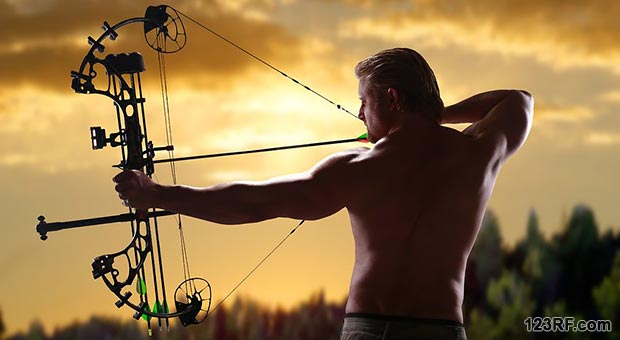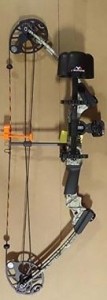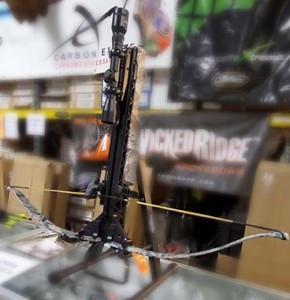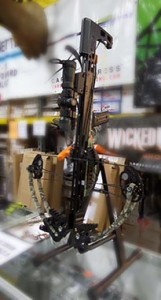
As with choosing the right gun or knife, you may find that one bow type and accessories will work better than others. As long as you choose a model that you can use easily and effectively, it will go a long way towards helping you provide food and protect yourself when SHTF.
Basic Bow Types
From early times, humans could hunt, fish, or defend at a distance with a bow and arrows. The first bow, or Long Bow, was nothing more than a thick branch with animal gut tied to each end to serve as the bow string.
As time went on the bows became longer and heavier. Their range became longer until shooting and hitting a target at over 100 yards was the norm. The main bow variations in use today include:
- Recurve Bow – has an additional curve on each end which magnifies the power of draw to increase distance, speed, and accuracy.
- Compound bows – uses a cam system to create a smooth draw, high lift-off, and a more powerful arrow flight.
- Crossbow – This bow is held horizontal to the ground. It has a stock mounted at the center of the bow arms, which can be used to mount scopes, and serve as the bolt path. A foot stirrup is located on the front center of the bow, and is used to pull the string back and arm the bow. Since the bow arms are thicker and heavier, the crossbow superior to standard bows. To fire, place a bolt in the groove, aim, and pull the trigger. As with standard bows, you can buy recurve and compound designs. Modern body armor cannot stop a bolt from a good quality crossbow, but can usually deflect arrows from conventional bows.
WARNING: When shooting a crossbow, keep a tight hold the hand grip, and do not allow your fingers to slide upward, or the string will cut your fingers off with ease.
Long Bow
This bow was made from the heart wood of the Ash, Yew, or the Oak tree, and should be the same height as the person using it. Traditionally this bow does not use modern sights thus the accuracy may not be as good as modern bows, but in its day it was good enough to put food on the table or kill an enemy.
This is a weapon that should not be under estimated. Long bow costs range from $88.00- $583.99, and are usually made from wood or fiberglass, although I made my bow many years ago from Ash wood and deer gut.
Recurve Bow
This bow is made of Ash, yew, or oak, with lamination for extra strength. Unlike the long bow, it has a curve at each end that makes it possible to take deer on the first shot with good placement.
I Prefer the Greatree Archery Deerslayer recurve bow with a 50 lb draw. The workmanship and sight on the bow are both good, and worth the 223.00 investment on this bow.
Compound Bow

- The pulley/cam system make it easy to use by just about anyone. A 50 pound draw can be done with less than 30 pounds of pull.
- These bows are not affected by temperature or humidity.
- Since it takes less energy to hold the string back, you can take more time to aim.
My preference – the Venture compound bow which is part of the Mission Series by Mathews, which runs around $499.00. This is a durable bow with an adjustable draw weight from 50 to 70 lbs. It makes a good starter bow for teens, yet has more than enough power for adult men and women.
Recurve Crossbow

These bows are stronger, lighter, faster, and safer than their old counterparts.
My preference is, for sure, The Matrix 355 by Excalibur, which is a very good recurve crossbow priced at $899.99. This crossbow comes with a good accessory package containing a Tact-zone scope with 30mm rings, a four bolt quiver with bracket, four Diablo bolts with 150 grain field points, and a rope cocking aid.
Compound crossbow

The pulley/cam systems also give greater accuracy and allow for a longer aiming time and faster second shots.
My preference is The Invader Crossbow by Ten Point Is a no nonsense hunting crossbow that runs around 500.00 for the basic package.
It comes with a Ridge-Dot 40mm multi-dot scope, self-retracting rope-cocking system, and a detachable 3 bolt quiver.
In conclusion, the bow and arrow have changed much through time, yet each type still serves an important purpose. As you search for the best bow for hunting and survival, keep in mind your physical condition and what you want to use the bow for.
Always remember that long term survival after SHTF can be seriously hampered by failure to practice, or choosing cheap equipment now that will fail to work properly later on.
This article has been written by Fred Tyrell for Survivopedia.
Pictures for the compound bow, recurve crossbow and compound crossbow: courtesy of Dancer’s Sporting Goods.









Rick Conley | April 16, 2014
|
Some of Fred’s comments about seem to reinforce his expertise with firearms. Not sure how long ago he wrote this but today you can spend over $1,000 on a long bow. The curve on a recurve bow’s limbs do not make it any more accurate than a long bow – Fred says ” that makes it possible to take deer on the first shot with good placement.” No, the archer is what makes that possible, not the bow type. You cannot draw a 50 pound compound with “less than 30 pounds of pull”. By definition, a 50 pound compound requires 50 pounds of pull at peak. The compound advantage is at full draw (past the peak) the cams relax the holding weight to only 50 – 80% of peak weight. So at full draw you may only be holding 10 pounds with a 50 pound compound bow. He also says a compound has “high lift-off, and a more powerful arrow flight.” I don’t know what that means but the “power” of an arrow is dependent on arrow speed and weight – not bow type. He says “the crossbow superior to standard bows”. If he’s including compounds, not true. Multiple field tests have demonstrated that a modern compound is comparable to a modern crossbow. Finally “Modern body armor cannot stop a bolt from a good quality crossbow, but can usually deflect arrows from conventional bows” is also untrue as an arrow from a compound penetration is equivalent to a crossbow, depending on arrow weight and speed.
Bob Morton | April 17, 2014
|
Just one small addendum. A long bow and a crossbow are both good weapons, and both can serve to defend or put meat on the table. The difference(s) that I find are:
Learnng curve: It takes years to be really good with a long bow, and to be really good requires consistent practice, but I can make a dangerous marksman of a 12 year old girl in an hour.
Body Frailty: As we get older, or suffer more injuries, eventually there are body parts that don’t handle the tension that holding a long bow requires (said the 70-year-old man) while aiming. This affects accuracy. However, a crossbow can be cocked and loaded by an old guy, and then he only has to support part of the weight of the weapon while he aims.
Bob Morton
LameBear | April 17, 2014
|
As a lifelong archer and as a bowyer ….. NONSENSE!
Ken | April 17, 2014
|
I started shooting (archery) in 1948 when I was 8 years old with a cut-down and re-tillered osage orange bamboo-backed bow.There are several things that need to be considered in using archery tackle.In a SHTF situation,the KISS principle will apply.Using a stick bow such as a long bow,a flat bow,or a recurve bow allows you,should you break a string,to simply replace it.A compound,on the other hand,requires a bow press,and certain hand tools in order to repair or replace a string,a cable,a cam,etc.If you’re climbing up the side of a mountain or such,your hunt is over.If you’re being pursued by whomever,you’re screwed if you’re down to having only your bow as a defense.Same applies to a cross-bow.The more parts you have,the more things you have to fix when all those parts might break,and the more you have to have to fix them.
Now,addressing the subject of pull vs. hold:If you have a 50 lb. pull @ 28″,you need to be able to raise a 50 lb. weight 28″ and hold it there with one hand.This requires good back and arm strength.The penetration of the arrow is dependent upon arrow weight,speed,and point shape.With a compound bow,factors will depend on the design of the bow’s cams,linbs,and riser.Some bows will have a 50% break,some more or less than that.So if your bow is set at 50%,that means that you still will have to draw 50 lbs. but you will be holding 25 lbs. after the peak.
Most crossbows on the market – that is,the affordable ones,are somewhere around 150 lbs. to 220 lbs. cocking force.That means that without the use of a cocking pulley/rope,a cat’s claw,or lever,a 12 year old girl will have a great deal of trouble pulling back on 150 – 220 lbs. by hand.So would most men.Compound crossbows are generally faster,but a more complicated,heavier,and a whole lot more expensive.For me,my SHTF archery tackle is a bamboo – backed hickory bow.
katherine | April 18, 2014
|
where can I get a bamboo hickory long bow?
Ken | April 19, 2014
|
One of the best places currently to get hickory bows is through rudderbows.com.They sell different types (longbow,flatbow,backed,unbacked,and tri-laminated).They also will craft your bow in your own draw weight.Rudderbows sells on e-bay,so there is a chance that you could get a bow at auction at a huge saving in price,but the bow prices are so reasonable you can use the buy-it-now feature.For a bigger selection,go directly to the rudderbows website.
There are other makers that sell on ebay as well.I have found all of these bowyers to be fine craftsmen and honest merchants.
Good luck,and good shooting.
Pingback:Survival Defense When Guns Are Not Allowed | Survival skills, survival guns, survival guide | August 30, 2014
|
Pingback:How To Use Feathers For Your Homestead | Survivopedia | December 16, 2015
|
Pingback:How To Use Feathers For Your Homestead | Prepper's Survival Homestead | December 16, 2015
|
Pingback:How To Use Feathers For Your Homestead | | disasterdefense.us | December 16, 2015
|
Pingback:How To Use Feathers For Your Homestead - Backdoor Prepper | December 17, 2015
|
Pingback:5 Little-Known Cold Weapons For Your Defense | Prepper's Survival Homestead | May 10, 2016
|
Pingback:5 Little-Known Cold Weapons For Your Defense | | disasterdefense.us | May 11, 2016
|
Pingback:5 Little-Known Cold Weapons For Your Defense | Survivopedia | February 12, 2018
|